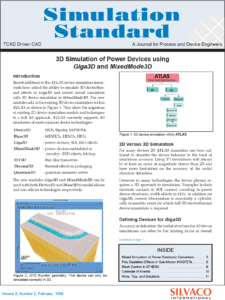3D Simulation of Power Devices Using Giga3D and MixedMode3D
Recent additions to the ATLAS device simulation framework have added the ability to simulate 3D electrothermal effects in Giga3D and mixed circuit simulation with 3D device simulation in MixedMode3D. The new modules add to the existing 3D device simulation within ATLAS as shown in Figure 1. They show the migration of existing 2D device simulation models and techniques to a full 3D approach. ATLAS currently supports 3D simulation of most common device technologies:
Device3D – MOS, Bipolar, EEPROMs
Blaze3D – MESFETs, HEMTs, HBTs
Giga3D – power devices, SOI, ESD effects
MixedMode3D – power devices embedded in circuitry , ESD effects, latchup
TFT3D – thin film transistors
Thermal3D -thermal effects in packaging
Quantum3D – quantum moments solver
The new modules Giga3D and MixedMode3D can be used with both Device3D and Blaze3D to model silicon and non-silicon technologies respectively.
2D Versus 3D Simulation
For many devices 2D ATLAS simulation has been sufficient to describe the device behavior to the limit of simulation accuracy. Using 3D simulations will always be at least an order of magnitude slower than 2D and have more limitations on the accuracy of the initial structure definition.
However in many technologies the device physics requires a 3D approach to simulation. Examples include substrate contacts in SOI, current crowding in power device structures, width effects in FETs. In addition for Giga3D, current filimentation is essentially a cylindrically symmetric event for which full 3D electrothermal device simulation is required.



